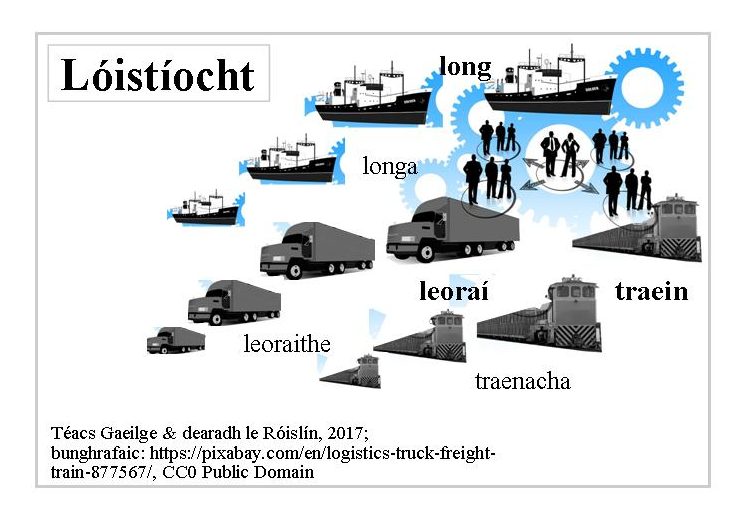Athleanúint don Athleanúint: Lóistíocht (Cuid/Part 1) Posted by róislín on May 24, 2017 in Irish Language
(le Róislín)
One good glossary (gluais) deserves another, I suppose one might say. The last blogpost was a vocabulary round-up for the post before that, which had managed to jump from discussing chips/French fries to logistics (naisc thíos). Today we’ll continue with a follow-up to the follow-up (athleanúint don athleanúint) with further discussion of some of the vocabulary. And there are so many areas of interest that this post will be at least a two-parter, maybe three.
Most of the key words in the last post (comhuaineach, grafaic, lóistíocht, próiseáil, veicteoireach) were pretty thoroughly discussed, but there are a few, especially from the graphic, that might bear further attention. In the discussion below, I’ve labeled the keywords here with letters (A – F), and within the category for lorries and trucks, I’ve labeled them further by number, because there are so many types! Today’s entry covers cogwheels, ships, trains, and drones, but our main emphasis for this and the next few posts will be on truck and lorries. Today we’ll just be able to do the tip of the iceberg as far as lorries go! Níos mó níos moille!
(A) fiaclach, toothed, also used to describe “cogwheels”
(B) roth, wheel, singular, with “rothaí” as the plural. Many of you may have read the Gaeltacht classic, Rotha Mór an tSaoil. For a long time I took the literal translation for granted, “The great wheel of destiny/life.” The official title of the translation, by the way, is completely different (“The Hard Road to Klondike”). Anyway, I then found myself thinking, “Why ‘rotha,’ not ‘roth‘?” The final “-a” looked like a possessive ending (for saying “of a wheel”), but if that were the case, then why would it be at the beginning of the phrase. So “rotha” is definitely the main subject , and lo and behold, “rotha” turns out to be a variant singular form. At any rate, “rothaí” is plural.
So “cogwheel,” is “roth fiaclach,” (or it could be “rotha fiaclach” in dialect) and the phrase for “cogwheels” (plural) is “rothaí fiaclacha,” as we saw in graphic from the last post.
The methods of transportation shown in the graphic are probably pretty familiar but here’s a quick review. “Drón,” of course is fairly new and I wasn’t able to include one in the illustration (yet!).
(C) long, ship, with the following forms:
an long, the ship
na loinge, of the ship
na longa, the ships
na long, of the ships
(D) traein, train, with the following forms:
an traein, the train
na traenach, of the train (note how the “i” disappears)
na traenacha, the trains
na dtraenacha, of the trains
(E) drón, drone, with the following forms:
an drón, the drone
an dróin, of the drone
na dróin, the drones
na ndrón, of the drones
(F) leoraí, lorry, and trucail, truck: there’s a slew of interesting phrases based on “leoraí” and “trucail,” and although it wasn’t included last time, we can add “truiclín,” which finally showed up a few years ago in some Irish dictionaries as the word for “pick-up truck.” I had actually wondered about “pick-up truck” for years, debating if there was some way to use the phrase “piocadh suas.” Anyway, let’s look at “leoraí,” “trucail,” and “truiclín,” and a few of the contrasting phrases (articulated lorry/artic, tractor-trailer/semi/semi-trailer truck). It also seems to me that sometimes the words “leoraí” and “trucail” might be more interchangeable than the dictionaries and samples I’ve found indicate, especially in the Irish-speaking diaspora, where some folks, especially in the U.S. rarely think in terms of “leoraithe.” But I’ll attempt to give a usable introduction here.
(1) leoraí, lorry
an leoraí, the lorry
an leoraí, of the lorry (same as above)
na leoraithe, the lorries, which is the standard plural, but Mícheál Ó Siadhail, in his Learning Irish, listed “leoraís” as the plural. For pronunciation, he indicates /l’ori:s/, not the “s” sound that usually comes after “i,” which would be slender (as in “uisce” or “feis“). The pronunciation he indicates would be as in “piece” or “Reece” or “Rhys,” with a hard “s,” not a softer “z” sound as in “skis” or “bees.”
na leoraithe, of the lorries, the same as above
Some of the categories include:
articulated lorry: leoraí altach, pl: leoraithe altacha, lit. jointed lorry
breakdown lorry or breakdown truck, i.e. a tow truck: leoraí tarraingthe, pl: leoraithe tarraingthe, lit. lorry of pulling
right-hand drive lorry: leoraí deas-stiúrtha, pl: leoraithe deas-stiúrtha (as driven in Ireland, Britain, etc.). If I were just seeing the phrase “deas-stiúrtha” out of context, I might think it meant “well-steered,” since, technically, it does mean that also.
And, although, I find no trace of the phrase online, it’s easy enough to predict: left-hand drive lorry, leoraí clé-stiúrtha, pl: leoraithe clé-stiúrtha (as driven in the US, etc., but remember, Americans almost never say “lorry,” so we’ll repeat these phrases in the next blogpost, using “truck”!)
For a “tipper lorry,” and other types of “trucks,” we’ll look at “trucail” and “truiclín,” as well as leoraithe, sa chéad bhlagmhír eile, which will start with uimhir a dó san fhoshraith seo. SGF — Róislín
Naisc:
Comhuaineach, Grafaic, Lóistíocht, Próiseáil, Veicteoireach: Some Irish Vocabulary from the Previous Blog Posted by róislín on May 21, 2017 in
Irish Language‘Sceamhóg’ vs. ‘Scamhóg” in Irish (and for good measure ‘sceallóg’ and ‘scailleog’) Posted by róislín on May 16, 2017 in Irish Language

Build vocabulary, practice pronunciation, and more with Transparent Language Online. Available anytime, anywhere, on any device.





Leave a comment: